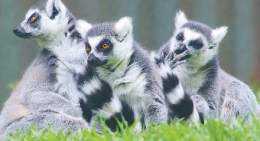Nuair a chríochnaigh mé an deichiú bliain ag obair do m’fhostóir, fuair mé bónas a chaith mé ar théacsleabhair theangacha éagsúla, mar is dual dom. After 10 years working for my present employer, I received a bonus which I spent on – what else? – textbooks of different languages, particularly ones I had no idea about.
Go bunúsach, teangacha a bhí i gceist nach raibh a fhios agam gurbh fhéidir iad a fhoghlaim. Ceann acu siúd ab ea teanga dhúchasach mhuintir Mhadagascar: an Mhalgáisis. Le fírinne, rinne mé iarracht dháiríre anuraidh Malgáisis a fhoghlaim, agus cé go bhfuil an chuid is mó di dearmadta agam inniu, beidh sí go líofa agam an lá is faide anonn le cuidiú Dé, ó tá dúshraith mhaith agam inti anois.
Cé go bhfuil oileán Mhadagascar suite in aice le hilchríoch na hAfraice, ní teanga Afracánach í an Mhalgáisis ó thaobh a bunúis de. Tháinig sinsir mhuintir Mhadagascar ó Bhorneo, is é sin, ceann de na hoileáin mhóra ar cuid den Indinéis iad inniu. Mar sin, is teanga Malae-Pholainéiseach í an Mhalgáisis, agus í gaolmhar leis an Indinéisis, leis an Tagálaigis (arb í príomhtheanga na nOileán Filipíneach í) agus lena lán teangacha beaga a chloisfeá in oileáin an Aigéin Chiúin.
Ach ar ndóigh, fuair an Mhalgáisis a lán focal ar iasacht ó theangacha a timpeallachta geografaí. Bíonn a lán focal Fraincise i mbéal mhuintir Mhadagascar, ó ba iad na Francaigh a bhí ag rialú na tíre i ré an choilíneachais. Ón taobh eile de, tháinig focail áirithe isteach ón mBéarla, ó bhí misinéirí Sasanacha ag obair san oileán. Sampla de seo is ea an focal ar ‘leabhar’, ‘boky’.
Is féidir dearcadh ar ilchríoch na hAfraice mar pharthas don teangeolaí, nó tá sí foirgthe le teangacha éagsúla a mbainfeadh a gcuid foirmeacha agus an saibhreas fuaimeanna stangadh asat. A lán acu tá córais chasta réimnithe agus díochlaonta acu, agus catagóirí gramadúla iontu a chuirfeadh an dubhiontas ar an duine a mbeadh na seacht dteangacha Eorpacha aige. Is iomaí teanga Afracánach nach ndearna teangeolaithe na hEorpa is na Stát Aontaithe taighde ar bith uirthi go fóill.
Ón taobh eile de, níl mórán foirmeacha deacra ag an Malgáisis. Níl ach trí aimsir ag an mbriathar: an aimsir chaite, an aimsir láithreach agus an aimsir fháisteanach. Le réimíreanna a chuirtear an aimsir in iúl: m- a sheasann don aimsir láithreach (mamaky = léim, léann tú, léann sé 7rl), n- don aimsir chaite (namaky = léigh mé, tú, sé 7rl), agus is é h- réimír na haimsire fáisteanaí (hamaky = léifidh mé, tú 7rl).
Maidir leis an gcultúr, is é ceol Mhadagascar an ghné di is túisce a tharraingeoidh i leith na tíre thú. Tháinig a lán traidisiún difriúil i dteagmháil san oileán, ón amhránaíocht chóir is túisce a shamhlaímid leis an Afraic go dtí na huirlisí téide a fuarthas ón Eoraip agus a cuireadh in oiriúint don lucht éisteachta san oileán. Is é an tiúb bambú ar a dtugtar ‘valiha’ an uirlis náisiúnta, agus is dócha gurb é a fhágann a shainbhlas ar cheol Mhadagascar.
Nuair a d’fhoghlaim mise Gaeilge, fuair mé aithne ar cheol na hÉireann, agus is le fada a shíl mé nach raibh a shárú ann, mar cheol, ach caithfidh mé a rá anois go bhfuil: ceol Mhadagascar.
An té ar mhaith leis a fháil amach cén fáth a bhfuil an grá seo agam do cheol Mhadagascar, ní mór dó ainm amháin a fhoghlaim de ghlanmheabhair: Levelo, is é sin, Jean Rakotoarivelo. Fuair Levelo, máistir cheol Mhadagascar, bás sa bhliain 2009, agus níor shlánaigh sé bliain thar an leathchéad. Is í Tarika an cheolfhoireann a chanann is a sheinneann saothar Levelo, go bhfios dom. Ach ar ndóigh, ní dheachaigh stíleanna an cheoil chomhaimseartha thart le Madagascar gan a n-aithne a fhágáil ar an oileán. Is é saothar Samoela – amhráin cosúil le ‘Zana-Pokonolo’ – is mó a léiríonn sin.
Tá Panu Höglund scríbhneoir Fionlannach ar líne agus aistritheoir
One of these was the native language of the people of Madagascar: Malagasy. And indeed, I did make a serious attempt last year to learn it. Although I have by now forgotten almost everything, I will be proficient one day, God willing, as I have a good foundation in it now.
Although the Island of Madagascar is next to the continent of Africa, its language is not originally African. The ancestors of the Malagasy people came from Borneo, one of the great islands today part of Indonesia. Thus, the language is of Malayo-Polynesian stock, related to Indonesian, Tagalog (which is the most important language of the Philippines) and a lot of small languages spoken in the Pacific islands.
But obviously Malagasy borrowed a lot of words from the languages of its geographic environment. Malagasy people use lots of French words (France being the ruling power in the days of colonialism). On the other hand, certain words came in from English because British missionaries were active in Madagascar. An example is the word for ‘book’, which is ‘boky’ in Malagasy.
The continent of Africa can be called a linguist’s paradise, because it is full of different languages whose forms and richness of sounds would astonish you. Many of them have intricate systems of conjugations and declensions, with grammatical categories that would amaze even a multilingual European. Many African languages have not yet been studied at all by European or American linguists.
On the other hand, Malagasy has few difficult forms. Verbs have only three tenses: past, present and future. Tenses are expressed with prefixes: m- is the present (mamaky = I am reading, you are reading, etc), n- is the past (namaky = I read, you read, he read, etc), and h- gives the future (hamaky = I will read, etc).
As regards the culture, in Madagascar it’s above all the music that attracts you to the country. Lots of different traditions came together in Madagascar, from the choir singing usually associated with Africa to the string instruments adopted and adapted by Malagasy musicians. The bamboo tube called valiha is the national instrument, probably the reason for why Malagasy music is so special.
When I learnt Irish, I obviously got to know the music of Ireland too, and for a long time I thought there was no music more beautiful than it, but I’m afraid I must change my mind now: there is Malagasy music.
Whoever wants to know why I love the music of Madagascar so much needs to learn one name by heart: Levelo. The master of Madagascar music, real name Jean Rakotoarivelo, died in 2009, only 50 years old. His music is today played and sung by the band Tarika. But of course more contemporary styles did not leave Madagascar untouched either. This can be most aptly demonstrated with the songs of the artist Samoela such as ‘Zana-Pokonolo’.
Panu Höglund is a Finnish online writer and translator












